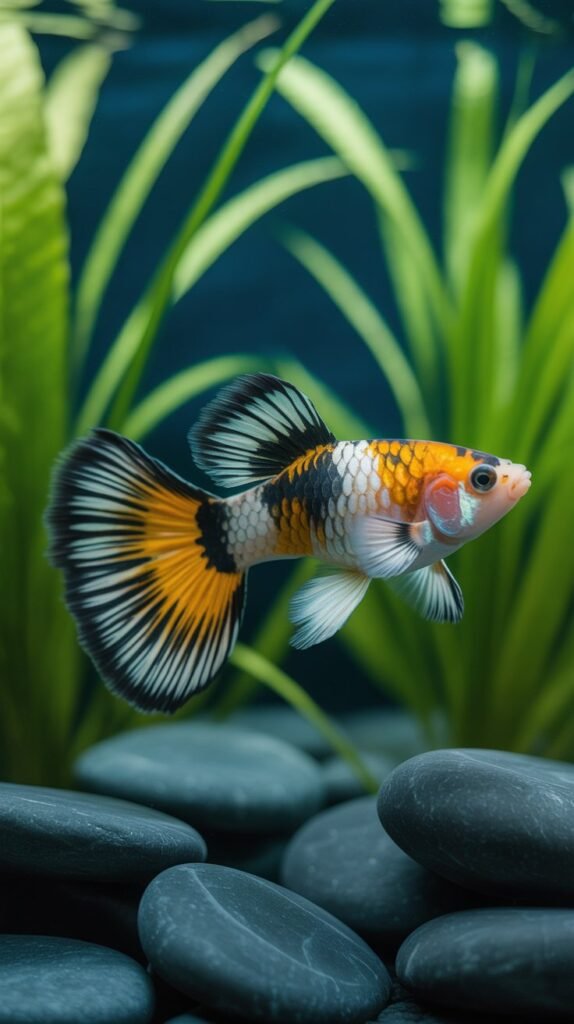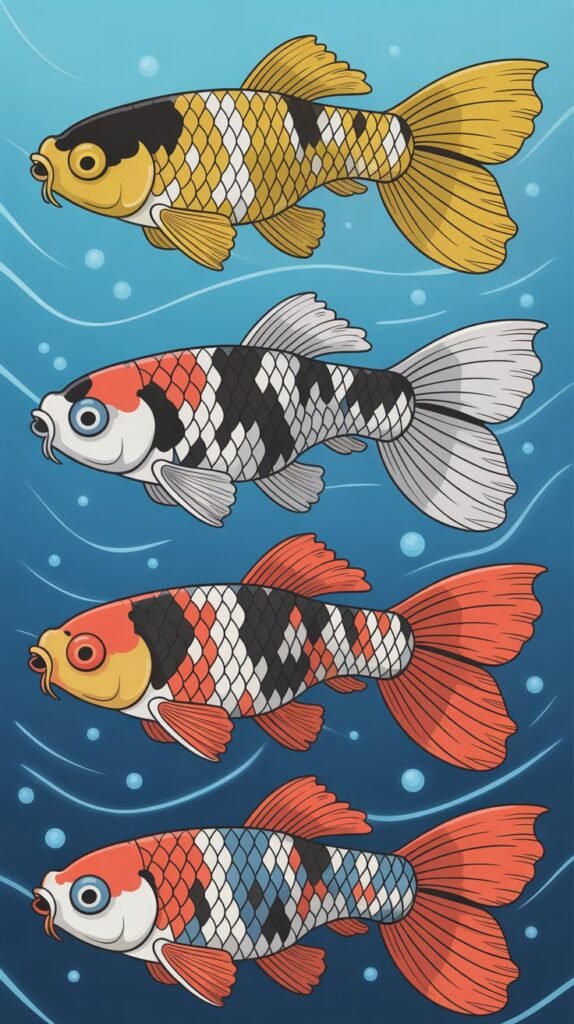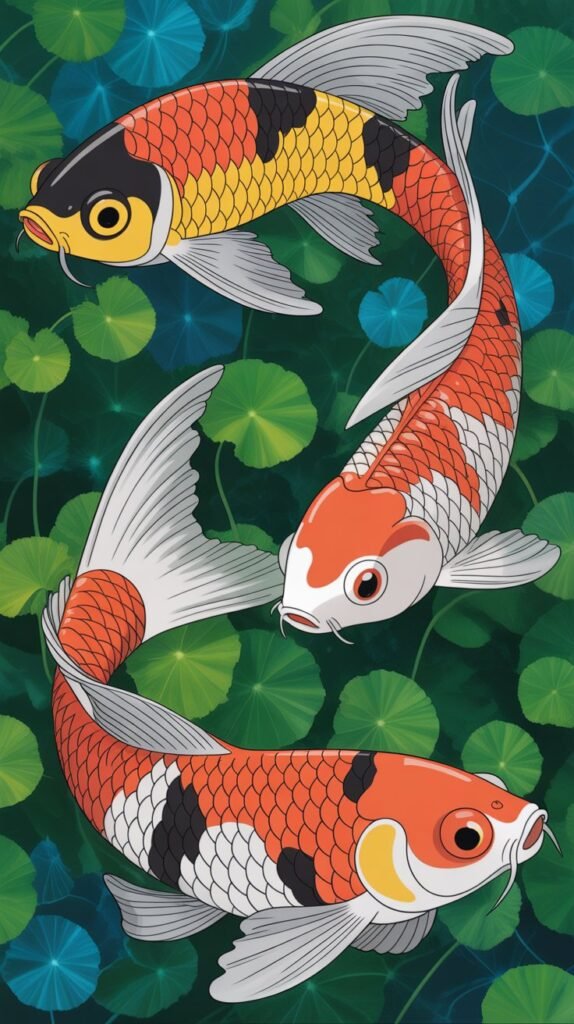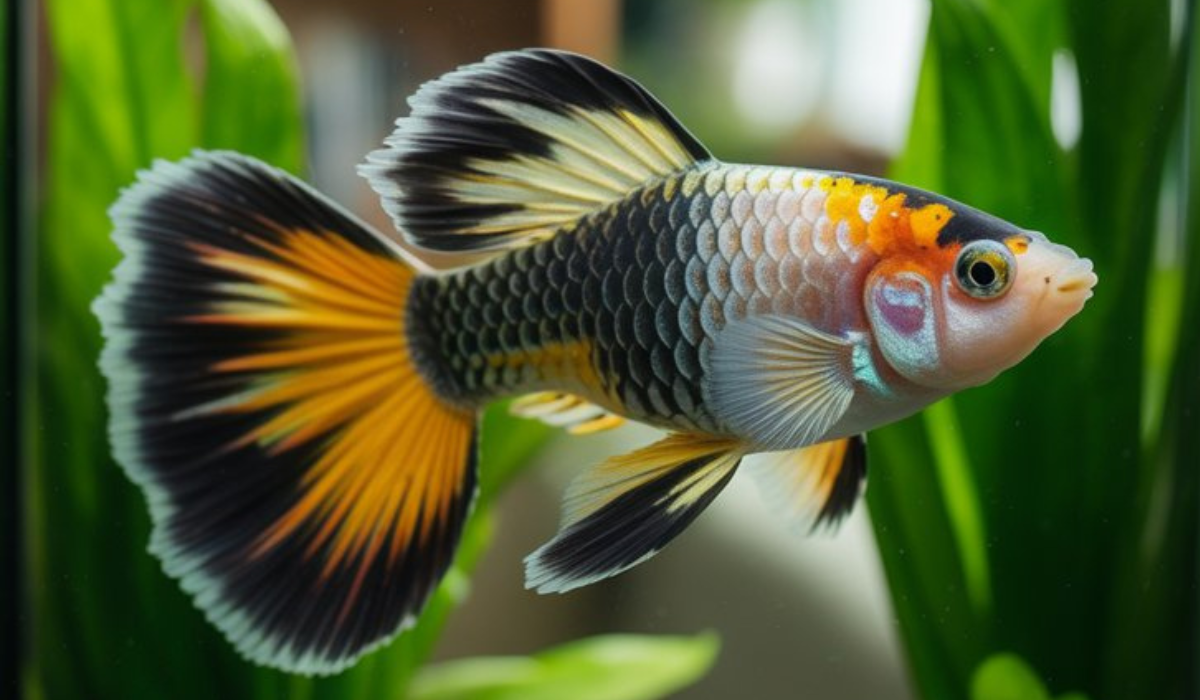The Koi Mosaic Guppy is one of the most stunning and sought-after varieties in the world of ornamental fish. With its vivid koi-like coloration, shimmering mosaic tail pattern, and graceful movement, this guppy has captured the hearts of aquarists around the globe.
Whether you’re an experienced breeder or a beginner looking for an eye-catching fish for your aquarium, the Koi Mosaic Guppy is an excellent choice. In this detailed guide, we’ll cover everything you need to know about this beautiful variety — from its origins and appearance to tank setup, feeding, and breeding tips.
What Is a Koi Mosaic Guppy?
The Koi Mosaic Guppy is a selectively bred guppy (Poecilia reticulata) that combines the distinctive coloration of koi fish with the elegant tail patterns of mosaic guppies. The result is a fish that looks like a miniature koi swimming gracefully with a radiant, fan-shaped tail.
This variety was developed by expert breeders in Asia, especially Thailand and Indonesia, who aimed to create guppies that exhibit koi-inspired red-orange heads and mosaic-patterned tails. The result is a truly striking guppy that’s both colorful and hardy.

Scientific Classification
- Scientific Name: Poecilia reticulata
- Common Name: Koi Mosaic Guppy
- Family: Poeciliidae
- Origin: Selectively bred in captivity (Asia)
- Type: Fancy Guppy
Appearance and Coloration
The Koi Mosaic Guppy stands out due to its vivid color palette and distinctive tail pattern. It displays the classic “koi” traits — a red or orange head with white, silver, or golden body shades — combined with a stunning mosaic tail.
Key Features:
- Head: Typically deep red or orange, similar to koi fish markings.
- Body: May show metallic or pastel colors such as silver, white, blue, or gold.
- Tail: The highlight of the fish, featuring intricate “mosaic” patterns with streaks or dots in blue, red, and black.
- Fins: Flowing and semi-transparent, often displaying subtle color gradients.
- Size: Males grow up to 1.5 inches (3.8 cm), females up to 2.5 inches (6.4 cm).
Each Koi Mosaic Guppy has its unique color pattern, making every fish a one-of-a-kind specimen in the aquarium.
Male vs. Female Koi Mosaic Guppy
Like other guppies, the male and female Koi Mosaic Guppies are easy to differentiate once they mature.
| Characteristic | Male | Female |
|---|---|---|
| Size | Smaller (1.5 in) | Larger (up to 2.5 in) |
| Coloration | More vibrant and detailed | Lighter and less intense |
| Tail/Fins | Longer, flowing fins | Shorter, rounded fins |
| Body Shape | Slender | Rounder, especially when pregnant |
| Behavior | Active and displays colors to attract females | Calm and less flashy |
Males are often the centerpiece of display tanks, while females are valuable for breeding programs.
Origin and Breeding History
The Koi Mosaic Guppy originated from selective breeding programs in Southeast Asia, primarily Thailand and Indonesia, regions famous for developing premium guppy strains.
Breeders combined Koi Guppies (known for their red heads and white bodies) with Mosaic Guppies (known for their patterned tails). The hybridization resulted in the Koi Mosaic Guppy, which inherited the vivid red koi coloration and intricate mosaic tail pattern.
This variety represents the perfect balance between artistic beauty and natural grace — making it a favorite among guppy collectors.
Tank Setup for Koi Mosaic Guppy

Creating the right environment is crucial for maintaining the health, color, and vitality of your Koi Mosaic Guppies. These fish thrive in clean, warm, and well-planted aquariums that mimic their tropical origins.
1. Tank Size
- Minimum: 10 gallons for a small group
- Ideal: 20 gallons or larger for a community setup
Larger tanks ensure stable water parameters and provide plenty of space for swimming and breeding.
2. Water Parameters
| Parameter | Ideal Range |
|---|---|
| Temperature | 24°C – 28°C (75°F – 82°F) |
| pH | 6.8 – 7.8 |
| Hardness | 8 – 12 dGH |
| Ammonia/Nitrite | 0 ppm |
| Nitrate | <20 ppm |
Stable water conditions are vital — sudden changes in pH or temperature can stress your guppies and dull their colors.
3. Filtration
Use a sponge filter or hang-on-back filter to maintain water quality without creating strong currents. Gentle flow mimics their natural environment and prevents fin damage.
4. Lighting
Moderate LED lighting brings out the guppies’ bright red and blue tones. Avoid harsh light, as it can stress fish. Use a 10–12-hour light cycle for optimal growth and coloration.
5. Substrate and Décor
Choose a dark substrate (fine gravel or sand) to make their colors more vibrant. Add:
- Driftwood and rocks for natural aesthetics
- Live plants like Java Moss, Anubias, and Amazon Sword
- Floating plants for shade and fry protection
These decorations create a comfortable and natural habitat, reducing stress and enhancing overall health.
Tankmates for Koi Mosaic Guppies
Koi Mosaic Guppies are peaceful and sociable, making them ideal community fish. They get along with other calm and small species.
Compatible Tankmates:
- Neon Tetras
- Harlequin Rasboras
- Mollies and Platies
- Corydoras Catfish
- Otocinclus Catfish
- Cherry or Amano Shrimp
- Snails (like Nerite or Mystery snails)
Avoid Aggressive Species:
- Tiger Barbs
- Bettas
- Large Cichlids
- Fin-nippers like Serpae Tetras
A peaceful community ensures stress-free living and vibrant color expression.
Feeding the Koi Mosaic Guppy
A varied and nutritious diet enhances color intensity and keeps your guppies healthy and active.
Diet Essentials:
- High-Quality Flakes or Pellets: Formulated for tropical fish or guppies.
- Live/Frozen Foods: Brine shrimp, bloodworms, mosquito larvae, and daphnia boost protein intake.
- Vegetable Matter: Include spirulina flakes or blanched vegetables like spinach or zucchini.
Feed small amounts twice daily, ensuring all food is consumed within two minutes to prevent waste buildup.
Color Enhancement Tip:
Foods rich in carotenoids, spirulina, and astaxanthin help intensify red and orange tones in Koi Mosaic Guppies.
Breeding Koi Mosaic Guppies
Breeding Koi Mosaic Guppies is straightforward, even for beginners. However, maintaining the purity of the strain requires careful selection.
1. Setting Up a Breeding Tank
- Use a 10–20-gallon tank with gentle filtration.
- Maintain 26°C (79°F) water temperature.
- Add dense vegetation or spawning mops for fry shelter.
2. Breeding Behavior
Males court females with elaborate fin displays and persistent following. Once mating occurs, the female stores sperm and can produce multiple broods from a single fertilization.
3. Gestation and Fry Care
- Gestation Period: 21–30 days
- Fry per Batch: 20–60
- Fry Care: Move fry to a separate nursery tank to prevent adults from eating them.
Feed fry with baby brine shrimp, micro worms, or crushed flakes multiple times a day.
4. Maintaining Strain Quality
To preserve the Koi Mosaic’s vivid traits:
- Breed only the most colorful and healthy fish.
- Avoid mixing with other guppy strains.
- Select fry with the best red heads and mosaic tails for future breeding.
Common Diseases and Health Issues

Although hardy, Koi Mosaic Guppies can be prone to common tropical fish diseases if tank conditions are poor.
| Disease | Symptoms | Treatment |
|---|---|---|
| Ich (White Spot Disease) | White spots, rubbing against objects | Raise temperature gradually and use Ich medication |
| Fin Rot | Ragged or disintegrating fins | Improve water quality and use antibacterial treatment |
| Dropsy | Swollen body, pinecone scales | Isolate fish, treat with antibacterial medication |
| Fungal Infections | White cotton-like growths | Use antifungal treatment |
| Swim Bladder Disorder | Erratic swimming | Fast fish for 24 hours, feed boiled pea next day |
Prevention Tips
- Maintain pristine water quality with weekly water changes (20–25%).
- Quarantine new fish before adding them to your main tank.
- Avoid overfeeding.
- Keep tank temperature stable.
Healthy fish exhibit bright colors, active swimming, and strong appetites.
Water Maintenance Tips
Maintaining clean and stable water conditions ensures long-term health and vivid coloration.
- Perform weekly partial water changes (20–30%).
- Use dechlorinated or conditioned tap water.
- Clean filters monthly without replacing all beneficial bacteria.
- Vacuum debris from substrate regularly.
- Monitor parameters weekly using a reliable test kit.
Behavior and Temperament
Koi Mosaic Guppies are peaceful, playful, and highly social. They enjoy swimming in the middle and upper water columns, often in small groups. Males may display their fins and colors to compete for female attention, but serious aggression is rare.
Their gentle, interactive nature makes them ideal for community aquariums or planted displays.
Lifespan
Under optimal care, Koi Mosaic Guppies typically live for 2 to 3 years. With excellent nutrition and stable water conditions, some can live even longer.
Aquascaping Ideas for Koi Mosaic Guppy Tanks
Creating a visually pleasing setup enhances both aesthetics and fish comfort.
1. Natural Biotope
Use driftwood, rocks, and live plants like Anubias and Java Fern to mimic tropical environments. The natural colors contrast beautifully with the guppies’ vivid tones.
2. Planted Aquascape
Incorporate lush greenery (Vallisneria, Amazon Swords) and floating plants. The plants improve water quality and provide hiding places for fry.
3. Minimalist Display
A simple layout with dark sand and subtle lighting draws full attention to the fish’s vibrant mosaic tails and koi-like heads.
Why Choose Koi Mosaic Guppies?
- Exceptional Beauty: The blend of koi colors and mosaic patterns creates a striking visual appeal.
- Peaceful Nature: Perfect for community tanks.
- Easy Breeding: Suitable for beginners and hobby breeders alike.
- Hardy and Adaptable: Can thrive in a variety of freshwater setups.
- Interactive Behavior: Active swimmers that add life to your aquarium.
Tips for Keeping Koi Mosaic Guppies Healthy and Happy
- Maintain a consistent feeding schedule.
- Keep tank lights on for 8–10 hours daily.
- Use driftwood and leaf litter for natural tannins.
- Perform regular water testing.
- Provide adequate space for schooling and breeding.
Conclusion
The Koi Mosaic Guppy is an aquatic jewel — a perfect fusion of artistry and nature. With its koi-inspired red head, elegant mosaic tail, and peaceful temperament, it brings unparalleled beauty and serenity to any aquarium.
Whether you’re setting up a community tank, breeding for quality strains, or simply admiring their vibrant colors, Koi Mosaic Guppies never disappoint. With proper care, diet, and water conditions, they’ll thrive and reward you with their radiant display for years to come.
Frequently Asked Questions (FAQs)
1. What is a Koi Mosaic Guppy?
A Koi Mosaic Guppy is a fancy guppy variety known for its red koi-like head and beautifully patterned mosaic tail, created through selective breeding.
2. Are Koi Mosaic Guppies suitable for beginners?
Yes, they are hardy, easy to care for, and adaptable to a wide range of freshwater conditions.
3. What do Koi Mosaic Guppies eat?
They eat flakes, pellets, live or frozen foods like brine shrimp and daphnia, and vegetable-based foods like spirulina.
4. How big do Koi Mosaic Guppies grow?
Males grow to about 1.5 inches, while females can reach up to 2.5 inches in size.
5. Can Koi Mosaic Guppies live with other fish?
Yes, they coexist well with peaceful community species such as tetras, mollies, and Corydoras.
6. How often should I feed them?
Feed them twice a day in small amounts that they can finish within two minutes.
7. How long do Koi Mosaic Guppies live?
Their average lifespan is 2–3 years, depending on care, diet, and tank conditions.
8. Do they need a heater?
Yes, as tropical fish, they require a consistent temperature between 24°C and 28°C.
9. How often do they breed?
Females can give birth every 4–6 weeks, producing 20–60 fry per batch.
10. How do I enhance their colors?
Provide a nutrient-rich diet with carotenoid supplements and maintain clean, warm water with good lighting.
Final Thoughts:
The Koi Mosaic Guppy is a brilliant, peaceful, and rewarding addition to any aquarium. With its koi-inspired charm and mosaic tail artistry, it’s not just a fish — it’s a moving masterpiece that embodies the beauty of the aquatic world.

